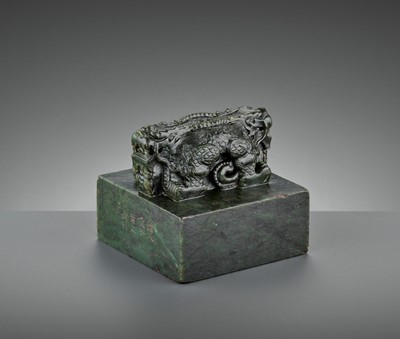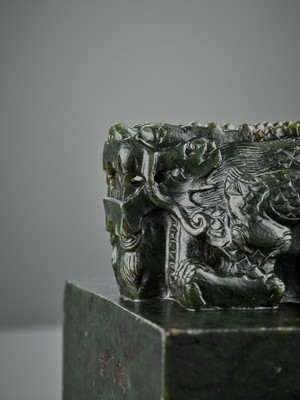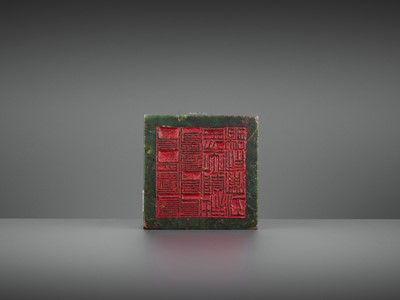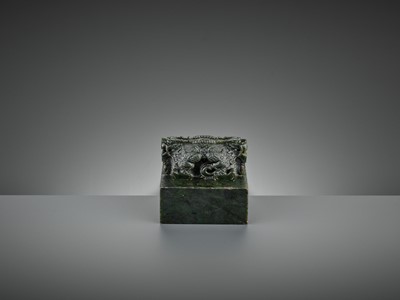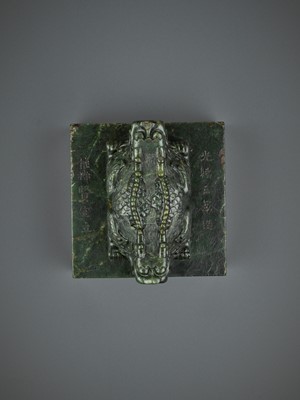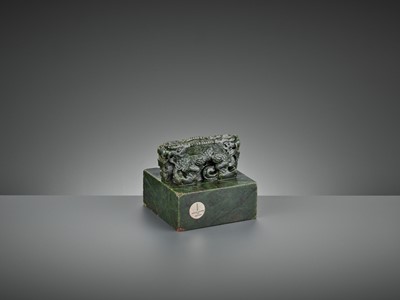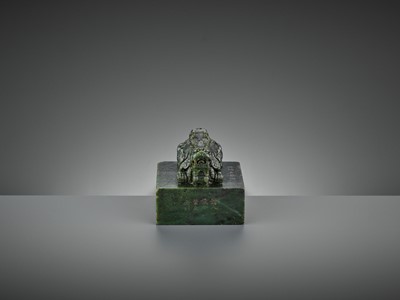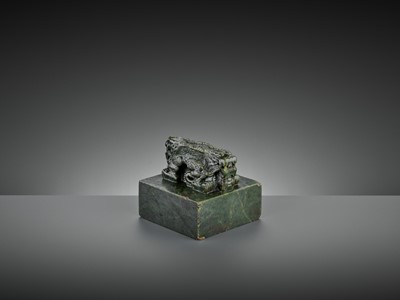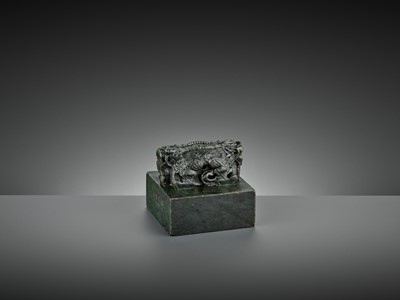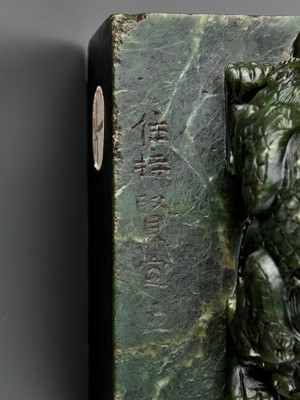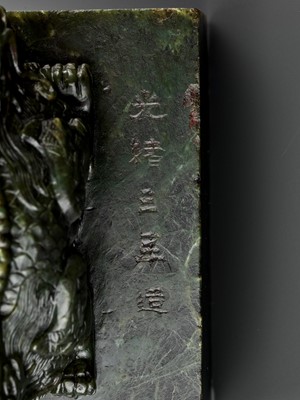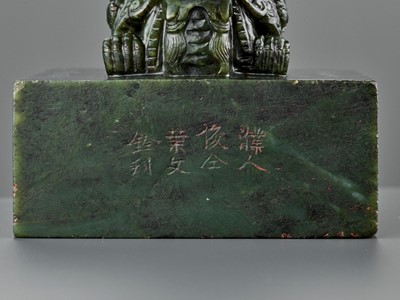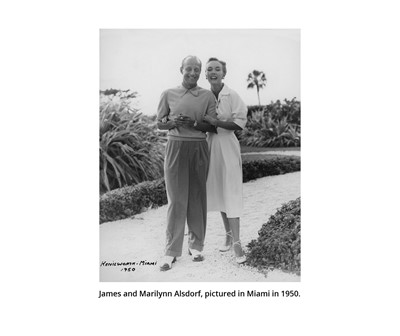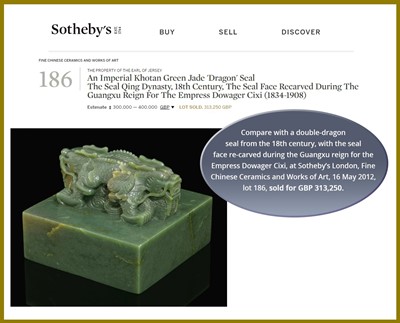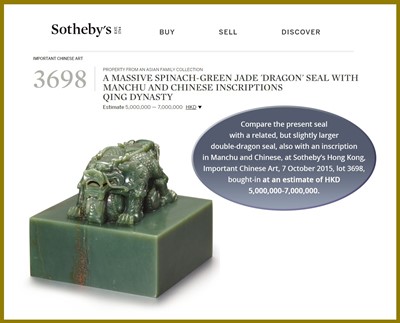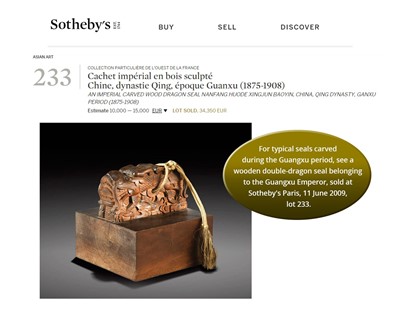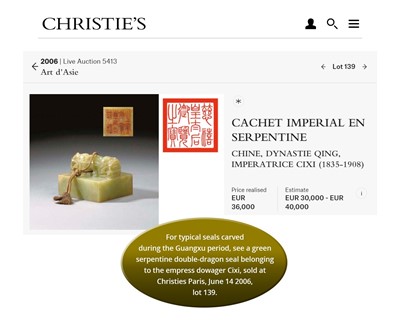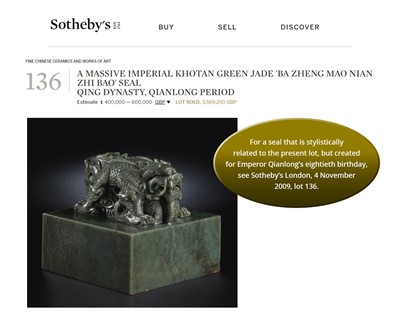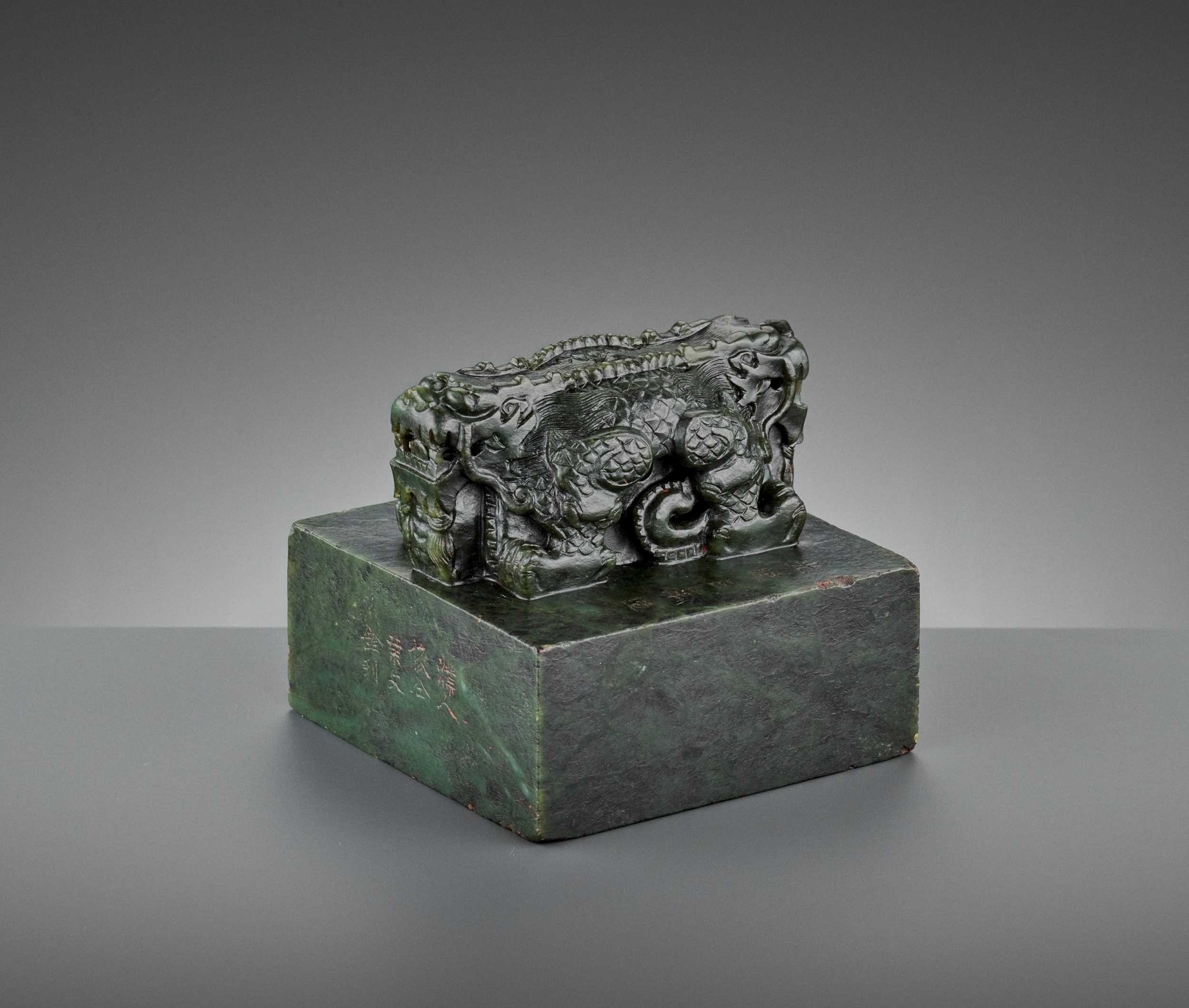5th Mar, 2021 10:00
TWO-DAY AUCTION - Fine Chinese Art / 中國藝術集珍 / Buddhism & Hinduism
64
AN IMPERIAL ‘DOUBLE DRAGON’ SPINACH-GREEN JADE SEAL, THE SEAL FACE INSCRIBED IN MANCHU AND CHINESE
御制碧玉滿漢文交龍鈕
Sold for €82,160
including Buyer's Premium
China, 18th century. Of large and massive square form, surmounted by a superbly articulated pair of addorsed dragons, each powerfully depicted with eyes bulging and nostrils flaring above curling whiskers and jaws bearing sharp fangs, the scales and flowing mane meticulously incised, the bodies tightly intertwined and crouching on the haunches.
The seal face inscription: ‘Jiangning fudu Chenghuang zhi yin’ (‘The seal of Chenghuang in the Capital of Jiangning’), written in both Manchu and Chinese. Chenghuang, god of the boundaries, is an important deity in China who protects the local people and affairs of a village, town, or capital, both in life and death.
The inscriptions incised to the sides, added in 1878: ‘Zhuchi Xianding li’ (consecrated by abbot Xianding), ‘Puren Juntong Ye Wenquan kan’ (amended by Ye Wenquan of Pu region) and ‘Guangxu san'nian zao’ (in the third year of the Guangxu reign). Ye Wenquan was an official during the Guangxu period, from Jiangsu province, who passed the imperial examination in 1890.
Provenance: Nicholas Grindley, Inc., Asian Works of Art, New York, 28 September 1982 (label to side). The James and Marilynn Alsdorf Collection, Chicago, USA, acquired from the above. Over four decades, the renowned couple assembled a remarkable collection with some of the biggest names of modern art, including René Magritte, Frida Kahlo, Joan Miró and Jean Dubuffet, as well as a significant number of highly important Chinese works of art. Nicholas Grindley (born 1951) is a well-known dealer and scholar of Chinese art. Since 1998 he has published two catalogs a year, and exhibited in London, New York and Hong Kong. Many works from these exhibitions are in museums and important private collections throughout the world.
Condition: Good condition with old wear, some nicks and nibbling to edges and corners, the stone with natural flaws, fissures and inclusions. Fine patina.
Weight: 1,678 g
Dimensions: Height 8.8 cm, Width 10.1 cm
The present seal illustrates the mastery of Imperial jade craftsmanship during the Qing Dynasty, and especially the Qianlong period. It appears to be one of the better-preserved examples of Imperial lapidary work from the 18th century and is notable for its high-quality jade of pure dark green color, vigorous rendering of the dragons, and inscriptions to the sides added during the Guangxu period. Large top-quality jade stones such as in the present example were not readily available during the later Qing dynasty. For this reason, seals inherited by emperors after 1850 were sometimes re-purposed and provided with additional inscriptions on various occasions.
The fine material, the fullness of the crouching body, the three-dimensionality in the facial features, and the intricately carved scales set the present seal clearly apart from the characteristic stiffness of typical Guangxu seals (see literature comparison further down below for two such seals). It is therefore concluded that despite the incised inscriptions to the top sides being dated 1878, the seal itself is from an earlier date – the Qianlong period. As opposed to the present lot, Imperial seals belonging to the Guangxu court and related officials, carved at the time, typically are of a lesser material, already reflecting the financial constraints of the period. The limited availability of good-quality jade stone during these days is demonstrated by the use of serpentine and wood in the production of Imperial seals. Several 'double-dragon' seals belonging to the Dowager Empress Cixi and made of serpentine are known, see the example sold at Christie's Paris, 14 June 2006, lot 139 (see literature comparison further down below). The reign of the Guangxu Emperor was witness to one of the most disruptive periods in the 5000-year history of China, which eventually led to the demise of the entire Qing Dynasty Empire. Naturally, these hard times saw a significant decline in both the quality of artwork created and the quality of materials available to the workshops.
Literature comparison: For typical seals carved during the Guangxu period, see a wooden double-dragon seal belonging to the Guangxu Emperor, sold at Sotheby's Paris, 11 June 2009, lot 233, and a green serpentine double-dragon seal belonging to the empress dowager Cixi, sold at Christies Paris, June 14 2006, lot 139. For a seal that is stylistically related to the present lot, but created for Emperor Qianlong’s eightieth birthday, see Sotheby’s London, 4 November 2009, lot 136.
Auction result comparison: Compare the present seal with a related, but slightly larger double-dragon seal, also with an inscription in Manchu and Chinese, at Sotheby’s Hong Kong, Important Chinese Art, 7 October 2015, lot 3698, bought-in at an estimate of HKD 5,000,000-7,000,000. Also compare with a double-dragon seal from the 18th century, with the seal face re-carved during the Guangxu reign for the Empress Dowager Cixi, at Sotheby’s London, Fine Chinese Ceramics and Works of Art, 16 May 2012, lot 186, sold for GBP 313,250.
御制碧玉滿漢文交龍鈕
中國,十八世紀。印面呈方形,立體高浮雕交龍鈕,神龍挺胸,龍首微昂,圓目張吻,平視前方,豎角橫須,鬃發飛揚,凜然神威。龍身捲曲交纏而龍首相背,龍爪緊抓印面,龍脊微隆,軀幹遒勁,威猛張揚。龍身鱗片雕琢精細。
印文:印文規整,刻工精湛,滿漢雙語,江寧福都城隍之印。
款識:光緒三年造;主持賢定立 ;濮人俊同葉文銓刊。
葉文銓,江蘇人, 1890年光緒時期進士。
來源:紐約Nicholas Grindley 亞洲藝術藝廊,1982年9月28日 (可見標簽)。美國芝加哥James and Marilynn Alsdorf 收藏,購於上述收藏。在過去的40年中,這對著名的夫婦收集了一系列非凡的藏品,其中包括一些現代藝術名人的作品,如René Magritte,Frida Kahlo,Joan Miró 和Jean Dubuffet,以及大量非常重要的中國藝術品。Nicholas Grindley 出生於1951,是知名中國藝術學者與商人。自1998 年起他出版了兩本畫冊並在倫敦、紐約和香港舉辦展覽。這個展覽裏的很多展品曾在全球重要博物館和私人收藏展出過。
圖片:1950年James 與 Marilynn Alsdorf在邁阿密
圖片:Nicholas Grindley
品相:狀況良好,有舊磨損,輕微划痕,邊角磕損,玉石有天然裂縫和內含物。 良好的包漿。
重量: 1,678 克
尺寸:高8.8 厘米, 寬10.1 厘米
這枚龍鈕碧玉章充分體現了清代對玉雕工藝的精通,並且似乎是該時期御用文物保存最完好的例子之一,純正的深綠色玉石,生動交龍紋以及兩側精湛的刻字。在本例子中,大型的優質玉石在19世紀後期並不容易獲得。 出於這個原因,有時會重新利用繼承的印章,並在各種場合增加額外的文字。
精美的材料,精湛的雕工,明顯不同於典型的光緒印章的特有硬度(請參閱下面的文獻比較,進一步了解這兩種印章 )。 因此得出的結論是,儘管上面刻有切刻的銘文是1878年,但封印本身必須是較早的日期,乾隆時期。相反的是,光緒朝廷和官員的印章材料等級較次,反映了該時期的財務限制,因此優質玉石的供應有限。這可通過使用蛇紋石和木料來生產皇家印章的現象來佐證。 慈禧太后“雙龍”印章是眾所周知的,請參見巴黎佳士得於2006年6月14日139號拍出的示例(請參見下面的文獻比較)。
文獻比較: 光緒時期的印章以光緒帝一件木製雙龍印售于巴黎蘇富比,2009年6月11日 lot 233;慈禧的蛇紋石雙龍印售于巴黎佳士得2006年6月14日 lot 139。一件乾隆八十歲閑章見倫敦蘇富比2009年11月 4日,lot 136。
拍賣結果比較:一件相近但更大的滿漢文雙龍印見香港蘇富比 Important Chinese Art拍場2015年10月7日,lot 3698, 估價HKD 5,000,000-7,000,000。慈禧雙龍印見倫敦蘇富比 Fine Chinese Ceramics and Works of Art拍場2012年5月16日 lot 186, 售價GBP 313,250。
China, 18th century. Of large and massive square form, surmounted by a superbly articulated pair of addorsed dragons, each powerfully depicted with eyes bulging and nostrils flaring above curling whiskers and jaws bearing sharp fangs, the scales and flowing mane meticulously incised, the bodies tightly intertwined and crouching on the haunches.
The seal face inscription: ‘Jiangning fudu Chenghuang zhi yin’ (‘The seal of Chenghuang in the Capital of Jiangning’), written in both Manchu and Chinese. Chenghuang, god of the boundaries, is an important deity in China who protects the local people and affairs of a village, town, or capital, both in life and death.
The inscriptions incised to the sides, added in 1878: ‘Zhuchi Xianding li’ (consecrated by abbot Xianding), ‘Puren Juntong Ye Wenquan kan’ (amended by Ye Wenquan of Pu region) and ‘Guangxu san'nian zao’ (in the third year of the Guangxu reign). Ye Wenquan was an official during the Guangxu period, from Jiangsu province, who passed the imperial examination in 1890.
Provenance: Nicholas Grindley, Inc., Asian Works of Art, New York, 28 September 1982 (label to side). The James and Marilynn Alsdorf Collection, Chicago, USA, acquired from the above. Over four decades, the renowned couple assembled a remarkable collection with some of the biggest names of modern art, including René Magritte, Frida Kahlo, Joan Miró and Jean Dubuffet, as well as a significant number of highly important Chinese works of art. Nicholas Grindley (born 1951) is a well-known dealer and scholar of Chinese art. Since 1998 he has published two catalogs a year, and exhibited in London, New York and Hong Kong. Many works from these exhibitions are in museums and important private collections throughout the world.
Condition: Good condition with old wear, some nicks and nibbling to edges and corners, the stone with natural flaws, fissures and inclusions. Fine patina.
Weight: 1,678 g
Dimensions: Height 8.8 cm, Width 10.1 cm
The present seal illustrates the mastery of Imperial jade craftsmanship during the Qing Dynasty, and especially the Qianlong period. It appears to be one of the better-preserved examples of Imperial lapidary work from the 18th century and is notable for its high-quality jade of pure dark green color, vigorous rendering of the dragons, and inscriptions to the sides added during the Guangxu period. Large top-quality jade stones such as in the present example were not readily available during the later Qing dynasty. For this reason, seals inherited by emperors after 1850 were sometimes re-purposed and provided with additional inscriptions on various occasions.
The fine material, the fullness of the crouching body, the three-dimensionality in the facial features, and the intricately carved scales set the present seal clearly apart from the characteristic stiffness of typical Guangxu seals (see literature comparison further down below for two such seals). It is therefore concluded that despite the incised inscriptions to the top sides being dated 1878, the seal itself is from an earlier date – the Qianlong period. As opposed to the present lot, Imperial seals belonging to the Guangxu court and related officials, carved at the time, typically are of a lesser material, already reflecting the financial constraints of the period. The limited availability of good-quality jade stone during these days is demonstrated by the use of serpentine and wood in the production of Imperial seals. Several 'double-dragon' seals belonging to the Dowager Empress Cixi and made of serpentine are known, see the example sold at Christie's Paris, 14 June 2006, lot 139 (see literature comparison further down below). The reign of the Guangxu Emperor was witness to one of the most disruptive periods in the 5000-year history of China, which eventually led to the demise of the entire Qing Dynasty Empire. Naturally, these hard times saw a significant decline in both the quality of artwork created and the quality of materials available to the workshops.
Literature comparison: For typical seals carved during the Guangxu period, see a wooden double-dragon seal belonging to the Guangxu Emperor, sold at Sotheby's Paris, 11 June 2009, lot 233, and a green serpentine double-dragon seal belonging to the empress dowager Cixi, sold at Christies Paris, June 14 2006, lot 139. For a seal that is stylistically related to the present lot, but created for Emperor Qianlong’s eightieth birthday, see Sotheby’s London, 4 November 2009, lot 136.
Auction result comparison: Compare the present seal with a related, but slightly larger double-dragon seal, also with an inscription in Manchu and Chinese, at Sotheby’s Hong Kong, Important Chinese Art, 7 October 2015, lot 3698, bought-in at an estimate of HKD 5,000,000-7,000,000. Also compare with a double-dragon seal from the 18th century, with the seal face re-carved during the Guangxu reign for the Empress Dowager Cixi, at Sotheby’s London, Fine Chinese Ceramics and Works of Art, 16 May 2012, lot 186, sold for GBP 313,250.
御制碧玉滿漢文交龍鈕
中國,十八世紀。印面呈方形,立體高浮雕交龍鈕,神龍挺胸,龍首微昂,圓目張吻,平視前方,豎角橫須,鬃發飛揚,凜然神威。龍身捲曲交纏而龍首相背,龍爪緊抓印面,龍脊微隆,軀幹遒勁,威猛張揚。龍身鱗片雕琢精細。
印文:印文規整,刻工精湛,滿漢雙語,江寧福都城隍之印。
款識:光緒三年造;主持賢定立 ;濮人俊同葉文銓刊。
葉文銓,江蘇人, 1890年光緒時期進士。
來源:紐約Nicholas Grindley 亞洲藝術藝廊,1982年9月28日 (可見標簽)。美國芝加哥James and Marilynn Alsdorf 收藏,購於上述收藏。在過去的40年中,這對著名的夫婦收集了一系列非凡的藏品,其中包括一些現代藝術名人的作品,如René Magritte,Frida Kahlo,Joan Miró 和Jean Dubuffet,以及大量非常重要的中國藝術品。Nicholas Grindley 出生於1951,是知名中國藝術學者與商人。自1998 年起他出版了兩本畫冊並在倫敦、紐約和香港舉辦展覽。這個展覽裏的很多展品曾在全球重要博物館和私人收藏展出過。
圖片:1950年James 與 Marilynn Alsdorf在邁阿密
圖片:Nicholas Grindley
品相:狀況良好,有舊磨損,輕微划痕,邊角磕損,玉石有天然裂縫和內含物。 良好的包漿。
重量: 1,678 克
尺寸:高8.8 厘米, 寬10.1 厘米
這枚龍鈕碧玉章充分體現了清代對玉雕工藝的精通,並且似乎是該時期御用文物保存最完好的例子之一,純正的深綠色玉石,生動交龍紋以及兩側精湛的刻字。在本例子中,大型的優質玉石在19世紀後期並不容易獲得。 出於這個原因,有時會重新利用繼承的印章,並在各種場合增加額外的文字。
精美的材料,精湛的雕工,明顯不同於典型的光緒印章的特有硬度(請參閱下面的文獻比較,進一步了解這兩種印章 )。 因此得出的結論是,儘管上面刻有切刻的銘文是1878年,但封印本身必須是較早的日期,乾隆時期。相反的是,光緒朝廷和官員的印章材料等級較次,反映了該時期的財務限制,因此優質玉石的供應有限。這可通過使用蛇紋石和木料來生產皇家印章的現象來佐證。 慈禧太后“雙龍”印章是眾所周知的,請參見巴黎佳士得於2006年6月14日139號拍出的示例(請參見下面的文獻比較)。
文獻比較: 光緒時期的印章以光緒帝一件木製雙龍印售于巴黎蘇富比,2009年6月11日 lot 233;慈禧的蛇紋石雙龍印售于巴黎佳士得2006年6月14日 lot 139。一件乾隆八十歲閑章見倫敦蘇富比2009年11月 4日,lot 136。
拍賣結果比較:一件相近但更大的滿漢文雙龍印見香港蘇富比 Important Chinese Art拍場2015年10月7日,lot 3698, 估價HKD 5,000,000-7,000,000。慈禧雙龍印見倫敦蘇富比 Fine Chinese Ceramics and Works of Art拍場2012年5月16日 lot 186, 售價GBP 313,250。
Zacke Live Online Bidding
Our online bidding platform makes it easier than ever to bid in our auctions! When you bid through our website, you can take advantage of our premium buyer's terms without incurring any additional online bidding surcharges.
To bid live online, you'll need to create an online account. Once your account is created and your identity is verified, you can register to bid in an auction up to 12 hours before the auction begins.
Intended Spend and Bid Limits
When you register to bid in an online auction, you will need to share your intended maximum spending budget for the auction. We will then review your intended spend and set a bid limit for you. Once you have pre-registered for a live online auction, you can see your intended spend and bid limit by going to 'Account Settings' and clicking on 'Live Bidding Registrations'.
Your bid limit will be the maximum amount you can bid during the auction. Your bid limit is for the hammer price and is not affected by the buyer’s premium and VAT. For example, if you have a bid limit of €1,000 and place two winning bids for €300 and €200, then you will only be able to bid €500 for the rest of the auction. If you try to place a bid that is higher than €500, you will not be able to do so.
Online Absentee and Telephone Bids
You can now leave absentee and telephone bids on our website!
Absentee Bidding
Once you've created an account and your identity is verified, you can leave your absentee bid directly on the lot page. We will contact you when your bids have been confirmed.
Telephone Bidding
Once you've created an account and your identity is verified, you can leave telephone bids online. We will contact you when your bids have been confirmed.
Classic Absentee and Telephone Bidding Form
You can still submit absentee and telephone bids by email or fax if you prefer. Simply fill out the Absentee Bidding/Telephone bidding form and return it to us by email at office@zacke.at or by fax at +43 (1) 532 04 52 20. You can download the PDF from our Upcoming Auctions page.
How-To Guides
How to Create Your Personal Zacke Account
How to Register to Bid on Zacke Live
How to Leave Absentee Bids Online
How to Leave Telephone Bids Online
中文版本的操作指南
创建新账号
注册Zacke Live在线直播竞拍(免平台费)
缺席投标和电话投标
Third-Party Bidding
We partner with best-in-class third-party partners to make it easy for you to bid online in the channel of your choice. Please note that if you bid with one of our third-party online partners, then there will be a live bidding surcharge on top of your final purchase price. You can find all of our fees here. Here's a full list of our third-party partners:
- 51 Bid Live
- EpaiLive
- ArtFoxLive
- Invaluable
- LiveAuctioneers
- the-saleroom
- lot-tissimo
- Drouot
Please note that we place different auctions on different platforms. For example, in general, we only place Chinese art auctions on 51 Bid Live.
Bidding in Person
You must register to bid in person and will be assigned a paddle at the auction. Please contact us at office@zacke.at or +43 (1) 532 04 52 for the latest local health and safety guidelines.
